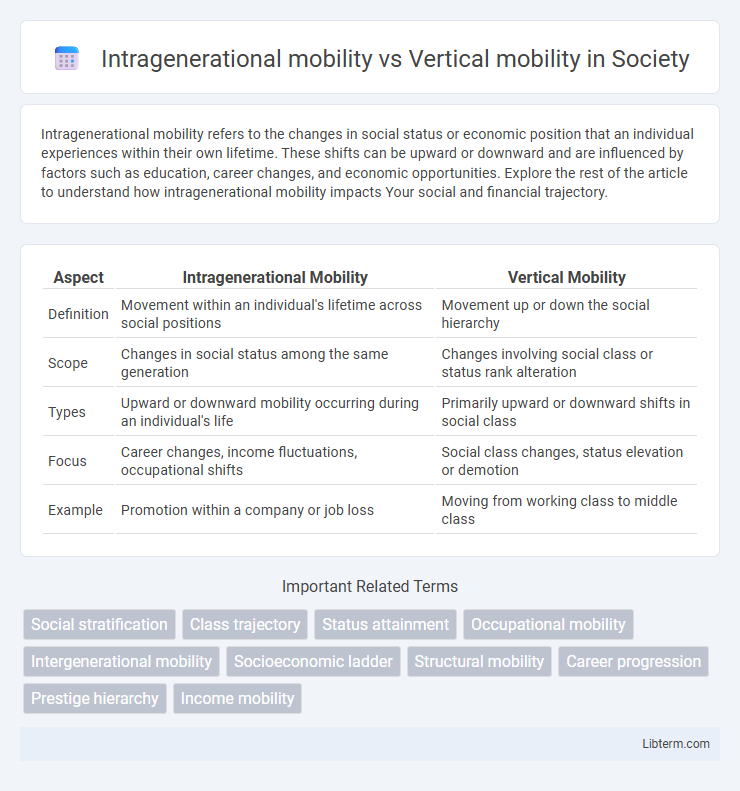Intragenerational mobility refers to the changes in social status or economic position that an individual experiences within their own lifetime. These shifts can be upward or downward and are influenced by factors such as education, career changes, and economic opportunities. Explore the rest of the article to understand how intragenerational mobility impacts Your social and financial trajectory.
Table of Comparison
| Aspect | Intragenerational Mobility | Vertical Mobility |
|---|---|---|
| Definition | Movement within an individual's lifetime across social positions | Movement up or down the social hierarchy |
| Scope | Changes in social status among the same generation | Changes involving social class or status rank alteration |
| Types | Upward or downward mobility occurring during an individual's life | Primarily upward or downward shifts in social class |
| Focus | Career changes, income fluctuations, occupational shifts | Social class changes, status elevation or demotion |
| Example | Promotion within a company or job loss | Moving from working class to middle class |
Introduction to Social Mobility
Intragenerational mobility refers to the changes in social status that occur within a person's lifetime, highlighting shifts in occupational status, income, or social class. Vertical mobility, a subset of social mobility, specifically involves movement upward or downward in the social hierarchy or class structure. Both concepts are crucial in understanding the dynamics of social mobility, which measures the ability of individuals or groups to change their social position over time.
Defining Intragenerational Mobility
Intragenerational mobility refers to the changes in an individual's social status or class position within their own lifetime, highlighting shifts such as career advancement or income changes over time. Vertical mobility, a subset of this concept, specifically involves movement up or down the social hierarchy, either through promotions or demotions. Unlike intergenerational mobility, which compares social status across different generations, intragenerational mobility centers on the dynamic social progress or decline experienced by one person during their life.
What is Vertical Mobility?
Vertical mobility refers to the movement of individuals or groups up or down the social hierarchy, typically measured by changes in socioeconomic status, income, or occupational prestige. It contrasts with intragenerational mobility, which examines changes within a single generation, by focusing on shifts in social standing across different social strata. Vertical mobility often indicates either upward mobility, such as promotions and income increases, or downward mobility, like job loss or reduced social rank.
Key Differences Between Intragenerational and Vertical Mobility
Intragenerational mobility refers to the changes in a person's social status within their own lifetime, while vertical mobility specifically involves movement between different social strata, either upward or downward. The key difference lies in scope: intragenerational mobility tracks social position changes over time for the same individual, whereas vertical mobility emphasizes hierarchical shifts in social class or economic status. Vertical mobility can be upward, such as a promotion to a higher income bracket, or downward, such as job loss leading to a lower socioeconomic position.
Factors Influencing Intragenerational Mobility
Intragenerational mobility refers to changes in an individual's social status within their lifetime, while vertical mobility involves movement up or down the social hierarchy. Key factors influencing intragenerational mobility include education level, which enhances skills and job opportunities, career changes prompted by economic shifts, and social networks that provide access to resources and information. Economic fluctuations and individual motivation also play critical roles in shaping the potential for upward or downward mobility within a single generation.
Examples of Vertical Mobility in Society
Vertical mobility refers to the movement of individuals or groups up or down the social hierarchy, often measured by changes in income, occupation, or social status. Examples include a factory worker becoming a corporate manager or a college graduate entering a low-paying job after internships, illustrating upward or downward vertical mobility, respectively. This contrasts with intragenerational mobility, which occurs within a single generation rather than across generations.
Socioeconomic Impacts of Both Mobility Types
Intragenerational mobility refers to changes in an individual's socioeconomic status within their lifetime, highlighting personal career progression and income shifts. Vertical mobility involves movement between different social strata or classes, impacting broader societal structures and access to resources. Both types influence economic equality, with intragenerational shifts affecting short-term financial stability and vertical mobility driving long-term social transformation and class dynamics.
Measuring Mobility: Metrics and Methods
Intragenerational mobility measures changes in an individual's social status over their lifetime, while vertical mobility specifically refers to upward or downward movement between social strata. Common metrics for measuring mobility include income percentile shifts, occupational status indices, and education attainment changes. Methods such as longitudinal surveys, panel data analysis, and social mobility matrices provide quantitative insights into the extent and direction of mobility within or across generations.
Barriers and Facilitators to Mobility
Intragenerational mobility refers to changes in social status within an individual's lifetime, while vertical mobility involves movement up or down the socio-economic ladder. Barriers to mobility include limited access to quality education, discrimination, and economic inequality, which restrict opportunities for upward movement. Facilitators of mobility encompass strong social networks, skill development programs, and equitable policies that promote fair access to resources and job markets.
Implications for Policy and Social Equity
Intragenerational mobility measures changes in an individual's social status within their lifetime, while vertical mobility refers specifically to upward or downward movement across social strata. Policies aimed at increasing intragenerational mobility focus on education access, workforce training, and income redistribution to reduce economic disparities. Enhancing vertical mobility is crucial for social equity, promoting equal opportunity and breaking systemic barriers that perpetuate poverty and social exclusion.
Intragenerational mobility Infographic

 libterm.com
libterm.com